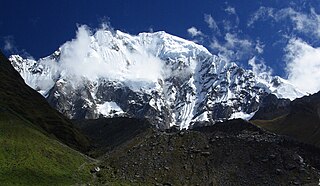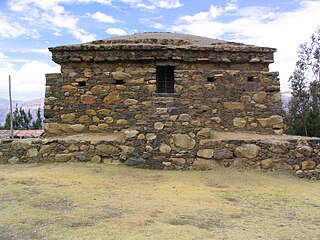
Huayno is a genre of popular Andean music and dance. It is especially common in Peru, Western Bolivia, Northern Argentina and Northern Chile, and is practiced by a variety of ethnic groups, especially the Quechua people. The history of Huayno dates back to colonial Peru as a combination of traditional rural folk music and popular urban dance music. High-pitched vocals are accompanied by a variety of instruments, including quena (flute), harp, siku (panpipe), accordion, saxophone, charango, lute, violin, guitar, and mandolin. Some elements of huayno originate in the music of the pre-Columbian Andes, especially on the territory of the former Inca Empire. Huayno utilizes a distinctive rhythm in which the first beat is stressed and followed by two short beats.

The Urubamba River or Vilcamayo River is a river in Peru. Upstream it is called Vilcanota River. Within the La Convención Province, the name changes to Urubamba. A partially navigable headwater of the Amazon River, the Urubamba rises in the Andes to the southeast of Cusco. It originates on the slopes of Cunurana in the Puno Region, Melgar Province, near the La Raya pass. It flows north-north-west for 724 km (450 mi) before coalescing with the Tambo River to form the Ucayali River.

Kichwa is a Quechuan language that includes all Quechua varieties of Ecuador and Colombia (Inga), as well as extensions into Peru. It has an estimated half million speakers.
Isla Incahuasi, Inkawasi or Inka Wasi, also known as Isla del Pescado, is a hilly and rocky outcrop of land and former island in Bolivia situated in the middle of Salar de Uyuni, the world's largest salt flat, at an elevation of 3,656 meters. It is located in the Potosí Department, Daniel Campos Province, Tahua Municipality, Yonza Canton.
Choquepuquio is an ancient Wari site in Peru in the valley of Cusco. These extensive ruins are situated in the Quispicanchi Province, Lucre District, near the village of Huacarpay and the homonymous lake.

Iñaq Uyu, also called Aklla Wasi, is an archaeological site in Bolivia situated on the Isla de la Luna, an island of Lake Titicaca. It is located in the La Paz Department, Manco Kapac Province, Copacabana Municipality In Incan society, the societal structure was very rigid. Often those of belonging to the royal class structure did not mix with the lower classes.

Kimsa Chata, also spelled Kimsachata, is a 4,735-metre-high (15,535 ft) mountain in the Andes in Bolivia. It is located in the Chilla-Kimsa Chata mountain range south-east of Wiñaymarka Lake, the southern part of Lake Titicaca. It lies in the La Paz Department, Ingavi Province, Tiwanaku Municipality, about 15 km south of the archaeological site of Tiwanaku and the village of the same name. Kimsa Chata is situated between the mountains Nasa Puqi in the north and Chuqi Ch'iwani in the south.

The Vilcabambamountain range is located in the region of Cusco, Peru, in the provinces of Anta, La Convención and Urubamba. It extends between 13°10' and 13°27'S. and 72°30' and 73°15'W for about 85 km. Its highest peak is Salcantay, which is 6,271 m (20,574 ft) above sea level.

Tarahuasi is an archaeological site in Peru. It is located in the Cusco Region, Anta Province, Limatambo District.
Titiqaqa is an archaeological site in Peru. It is located in the Cusco Region, Cusco Province, Cusco District, in the northeast of Cusco.

Wilcahuaín, Willcahuaín, or Huilcahuaín is an archaeological site in Peru. It is located near the village of Paria, 7 km northwest of the city of Huaraz, Ancash; at an elevation of 3,400 m (11,200 ft).
Taqrachullu, Pukara Taqrachullu, T'akrachullu, Pukara T'akrachullu or María Fortaleza is an archaeological site in Peru. It is located in the Cusco Region, Espinar Province, Suykutambo District.
Inka Mach'ay is an archaeological site in Peru. It is situated in the Huancavelica Region, Tayacaja Province, Ñahuimpuquio District.
Choquequirao Puquio is an archaeological site in Peru. It is situated in the Cusco Region, Cusco Province, San Sebastián District, north of San Sebastián.

Muyu Urqu is an archaeological site and a prominent hill in Peru. It is situated in the Cusco Region, Cusco Province, Santiago District, east of the mountain Araway Qhata, at the right bank of Watanay River. The mountain with the archaeological remains is about 3,400 metres (11,155 ft) high.
Ch'iyar Jaqhi is a mountain the Andes of Peru, about 4,654 m (15,269 ft) high. It lies in the Cusco Region, Canas Province, on the border of the districts Langui, Quehue and Yanaoca.
Purunllacta or Purum Llacta (Quechua purum, purun savage, wild / wasteland, llaqta place is an archaeological site of the Chachapoya culture in Peru. It is situated in the Amazonas Region, Chachapoyas Province, Cheto District, on the mountain of the same name. It lies northeast and near the archaeological site of Purunllacta of the Soloco District.
Wilca is an archaeological site in Peru. It is situated in the Amazonas Region, Utcubamba Province, in the east of the Cajaruro District, near the border with the Bongara Province.

Purunllacta or Purum Llacta (possibly from Quechua purum, purun savage, wild / wasteland, llaqta place is an archaeological site in Peru. It is situated in the Amazonas Region, Chachapoyas Province, Soloco District, southwest and near the archaeological site of Purum Llaqta of the Cheto District.
Waqlamarka is an archaeological site with walls and round burial towers (chullpa) in Peru. It is situated in the Junín Region, Jauja Province, Parco District.










